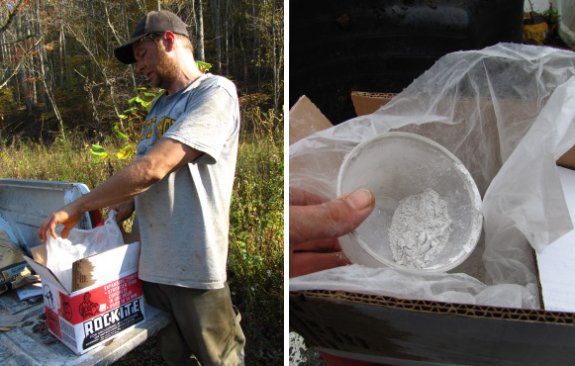
Using Rockite with a Ready-Mix concrete
Once upon a time I worked for
an industrial fence company, and sometimes we had to set a fence post
in sub-freezing conditions. The trick to making this work is to mix in
just the right amount of Rockite with the Ready-Mix concrete. The Rockite helped to
speed the process along, preventing the mixture from freezing.
I decided to apply this
technique to the creek
stepping stones where I
filled in the holes of each cinder block with 1 part Rockite to 8 parts Ready-Mix. A few of the holes had a fence
post driven through them to act as an anchor.
It seems like it worked, but
I won't know for sure until I see how well they stand up to the
constant pressure of our creek.
Want more in-depth information? Browse through our books.
Or explore more posts by date or by subject.
About us: Anna Hess and Mark Hamilton spent over a decade living self-sufficiently in the mountains of Virginia before moving north to start over from scratch in the foothills of Ohio. They've experimented with permaculture, no-till gardening, trailersteading, home-based microbusinesses and much more, writing about their adventures in both blogs and books.
Want to be notified when new comments are posted on this page? Click on the RSS button after you add a comment to subscribe to the comment feed, or simply check the box beside "email replies to me" while writing your comment.


It is probably a mixture of gypsum plaster and portland cement.
Both harden by hydration, the reaction with gypsum plaster being very fast and exothermic (releases heat).
According to the MSDS (PDF), it's 98% gypsum and 2% portland cement. I'm guessing the portland cement is added to give it a gray colour? Or maybe to improve the adhesion to surrounding concrete.
If you want to know the composition of something, looking for an MSDS is always a good idea.
There is a couple of caveats, which can vary depending on the jurisdiction the MSDS was made for.
So it is pretty unusual to find a 100% composition on an MSDS. In this case, both portland cement and plaster of paris are labelled as irritants, so that is why the numbers add up.
At a guess, I'd say plain plaster of paris is probably way cheaper... Especially if you buy it in bulk.
Selling plain stuff under a brand name for an inflated price is an age-old trick after all.